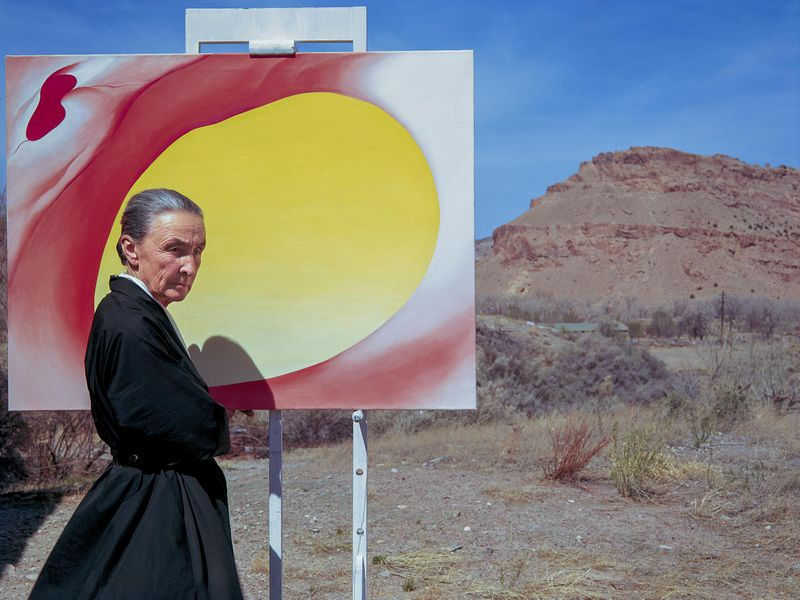Sally & Georgia O'Keefe
- swbutcher

- Jan 28, 2020
- 4 min read
Updated: Feb 3, 2020

In the late 1950’s the artist Georgia O’Keeffe travelled around the world and somewhere along the way sat next to a young woman on a bus. The woman, an amateur photographer, was my mother, Sally King Butcher. For my mother the bus ride was a small part of a post-college trip with her mother, my grandmother. For Georgia, the established painter, the tour was part of a longer exploration of the Far East and Africa; part of an effort to reinvigorate her artistic eye. For both women, my mother in her twenties, Georgia in her sixties, the tour was an opportunity to see sights they had only read about.
In the days preceding the bus ride Georgia and my mother spoke in passing several times as they were, for a few weeks at least, with the same tour group. Organized socials brought guests together for lectures, meals and other gatherings and so my mother and Georgia had chatted casually and had even discussed Georgia’s art. But now they sat side by side in a hot bus as it rumbled to the next destination.
The conversation eventually turned to photography and Georgia asked my mother what she thought of the work being done by another photographer of note, Ansel Adams. My mother, now in her 80s recalls little of the conversation more than fifty years ago but remembers Georgia asking her whether she considered Ansel Adams an artist.

Ansel Adams, born in the early 1900s, lived most of his life in the American West. His most famous photographs remain examples of high contrast, crisp focus and unmatched tonal quality in black and white. His images of the Yosemite area, where he lived for many years, drew attention to the National Park that bears its name and which many in the East had only heard of. Adams was one of seven photographers who, in the late 1930s formed Group f/64 after an aperture setting that yields a large depth of field leading to photos that are in focus both in the near foreground and the distant background. Adams’ photographs are noted for the ability to both make out the grains of sand at our feet and the tall pines in the distance.

Adams’ photographs were studies in what he called high contrast realism. He developed the Zone System in which photographers were encouraged to consider the broad spectrum of tones between pure white and pure black and to use these tones to capture the photographer’s emotion. Adams used the latitude of exposure, focus and composition to put on film what his mind’s eye saw. Adams believed that photography and specifically “straight photography” possessed no qualities of technique, composition or idea of any other art form other than photography. His photographs were to be devoid of the artist’s comment or interpretation beyond that captured by the photographer’s eye and the scene itself. Adams famously said that photographers do not take pictures, they make pictures.
In the late 1930s, around the time my mother was born, someone introduced Adams to Georgia O’Keeffe. The two became lifelong friends spending months together in the Southwest where she painted and he made photographs. Some of their most famous works came out of those years together.

By the 1950’s and early 1960’s though they remained friends, both Ansel and Georgia worked on independent projects. Georgia spent most of her time in the Southwest. Adams continued to photograph the West but also worked with his friend Edwin Land of Polaroid Corporation in Cambridge, Massachusetts. Adams helped Land perfect the instant color processing technique that would lead to the photographs we now simply call “Polaroid’s”. In the late 1950’s and early 1960, my mother, newly out of college, worked as a laboratory technician in the color lab for the same Edwin Land of the same Polaroid Corporation in Cambridge Massachusetts.
I asked my mother whether she ever met or even saw Ansel Adams when she worked at Polaroid and she laughed. Ansel Adams was a famous photographer and friend of Dr. Land. She was a lab tech. No, their paths did not cross. She was, however, an admirer of Adam’s work and considered his work inspiration in her own photography.
When my mother first told me the story of sitting on the bus with Georgia O’Keefe talking about painting, photography and Ansel Adams I asked her if she knew that Georgia and Ansel were friends. No, she said, she did not.
My mother recalls little of the conversation with Georgia but she does recall responding to Georgia’s question saying that she considered Adams both an artist and a photographer.
One will never know what O’Keeffe thought of my mother’s response but I like to think she considered it sound, accurate, and something that Adams himself would agree with. I like to think that after my mother answered Georgia’s question, Georgia turned; smiled to herself and thought Ansel would like to hear that.
Afterword:
My mother and Georgia O’Keeffe corresponded for many years after their trips abroad. My mother visited Georgia’s ranch in New Mexico and recalls sitting with Georgia looking at a recently published book of Georgia’s prints. In the early 1970’s when I was five my mother sent Georgia a print of a painting I made in school. Georgia replied that the print was “remarkable” and suggested that she would send three of her postcard prints if my mother sent her three of mine. I treasure the three postcard prints and the letter that accompanies them.




Comments